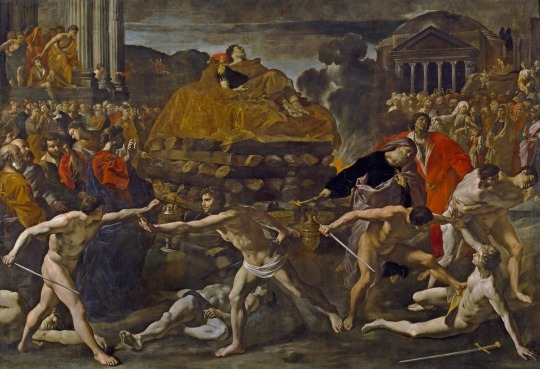#rites
Text

In the depths of the forest
Forgotten rites
#illustration#horror#scary#creepy#macabre#horror illustration#dark illustration#woods#horror blog#eerie#spooky#terrifying#rites#forest#fire#burn#burning#folk horror#art#macabre art#creepy art#horror art#cult#occultism
232 notes
·
View notes
Text

WITCH (The Modern Occult Magazine), Issue 1, 1970
#witches#alex sanders#occult#vintage#astrology#e.s.p.#herbalism#palmistry#magic#apprentices#demons#rites#issue 1#1970#magazine#occult products
60 notes
·
View notes
Text

Time to wake earth up!!
Joaldunak in Ituren (Nafarroa) make the cowbells sound to announce earth winter is gone and it has to wake up, and also to cast evil spirits of dark and cold out.
Pic and vid sources
#euskadi#euskal herria#basque country#pais vasco#pays basque#nafarroa#folklore#traditional masquerade#joaldunak#rites#paganism#culture#ituren#travel#places#wanderlust
270 notes
·
View notes
Text
When was circumcision first practiced? How did it evolve? Why was it practiced? The earliest literary evidence of the practice of circumcision goes back to ancient Egypt.
11 notes
·
View notes
Text

Funeral Rites for a Roman Emperor by Giovanni Lanfranco
#funeral#rites#roman#emperor#art#giovanni lanfranco#history#ancient rome#rome#antiquity#ancient#romans#europe#european#ancient roman#funerals#ritual#rituals#cremation#religious#religion
114 notes
·
View notes
Quote
The suppression of women's rights began with the suppression of women's rites.
Merlin Stone
When God Was A Woman

Trinity of the Moon
by Izabela Ewa Ołdak
169 notes
·
View notes
Photo

TRADITION | Toussaint, Samain, nuit d’Halloween et Fête des morts ➽ http://bit.ly/Samhain-Halloween-Toussaint Existant voici plus de 2500 ans et se déroulant tous les 31 octobre, la fête celtique de Samain fut adoptée par les Gaulois, marquant la fin de l’été et le début d’une nouvelle année. Grégoire IV fixant en 837 la Toussaint au 1er novembre, le Samain devint « Halloween »
#Fête#Celtes#Celtique#Gaulois#Samain#Samhain#Toussaint#Halloween#Jour#Morts#Religion#Année#Saisons#Coutumes#Traditions#Rites#31Octobre
15 notes
·
View notes
Note
Hey, I have a question about natron. You rinse your with it diluted in water before a ritual right? How much is it used of natron and water? My teeth suffer from enamel erosion and I'm uncertain about using natron. Sodium bicarbonate causes enamel erosion. I learned the hard way. Anyway. Thanks in advance.
so my understanding is that they had the concept of "pellets" or "grains" of natron, and that you'd plop a certain number of these grains/pellets into the water and that's how you'd figure out how much. when i've made my own natron, it did naturally break apart into little bits that might constitute as grains/pellets, and you could potentially measure yours that way, too.
so when i'd do it, i would probably stick one little grains worth in (maybe about the equivalent of a grain of rice or so) and call it a day.
however, i hate the taste of natron, and i'm not a huge fan of shoving it in my mouth. as you mentioned, sodium bicarbonate isn't good for your teeth, and i've spent way too much time trying to fix my teeth to subject them to stuff that's not good for them.
so it'd be my suggestion to just rinse your mouth out with water and call it a day. if you want something that's beneficial for the mouth, you could eat a spry/xylitol mint or something, to cleanse the mouth both figuratively and literally (xylitol sugar breaks down a lot of the bacteria that cause cavities in the mouth).
adhering to historical practice is fun and all, but from my perspective, the point was to cleanse your mouth, the thing you use to create the heka/words in the ritual. and so using clean water would work just as well. some may disagree, but, i've yet to see anyone get into trouble for opting for water (or nothing) instead of natron.
19 notes
·
View notes
Text
3 notes
·
View notes
Text
I wouldn't belittle the one who lights a candle during the day. It is purely symbolic. Even if there is a bright star glowing and lighting up the entire sky, I will have my own light. No matter how small it be is irrelevant. To have something of my own, that's what matters...
Random Xpressions
13 notes
·
View notes
Photo

Insight, issue 18, 1971
123 notes
·
View notes
Text
On death and its properties (visions on thanatology)
When one speaks of death, they are more often than not referring to the biological process that one's body goes through at a certain point of their life. There are a myriad of causes of death and yet, when someone dies, whether we are close to them or hear a stranger talking about the perished, our empathy towards them is kindled, and we are plagued by mental turmoil that may last for days, weeks, even years. Losses in our community shake us, especially when it is a loved one who passes away.
Death by old age, and by heart attacks, are the most prominent causes of one's passing. Suicide has progressively increased over the last decades - to which psychologists and sociologists (such as Émile Durkheim listing even 3 key reasons) have been trying to study the reasons that may cause an individual to take their own life.
When our biological functions cease, what happens to us both on Earth and afterwards is dependant on our beliefs, or the society we live in. In most modern societies, like our own, after an individual is formally considered to be dead, the funerary rites follow. Friends and relatives of the perished gather to be reminded of them one last time. In religious settings, after the prayers requesting for the defunct's peaceful rest are given, the corpse, placed inside a coffin beforehand, is lowered into a hole, being covered with dirt and being sealed under the ground. Per the defunct's will, however, the rites may be denied, or carried over with specific instructions. From there, the release of post-mortem chemicals, as well as insects, will finish off the remains.
As one would expect, the meaning of death varies according to each culture, and funerary rites are not universal. Anthropologist Bronislaw Malinowski gives us detailed information about the funerary rites of a Melanesian tribe:
"As soon as death has occurred, the body is washed,
anointed and adorned, sometimes the bodily apertures are filled,
the arms and legs tied together. Then it is exposed to the view
of all, and the most important phase, the immediate mourning
begins. Those who have witnessed death and its sequel among savages and who can compare these events with their counter-
part among other uncivilized peoples must be struck by the fundamental similiarity of the proceedings. There is always a
more or less conventionalized and dramatized outburst of grief
and wailing in sorrow, which often passes among savages into
bodily lacerations and the tearing of hair. This is always done in a public display and is associated with visible signs of mourning, such as black or white daubs on the body, shaven or dishevelled hair, strange or torn garments."(1)
As we can see, and as Malinowski himself states, the event of gathering to mourn over the defunct and the garments worn for this occasion is resemblant to the black colors normally worn by people attending a funeral in our developed societies. Malinowski also adds:
"The corpse, and with it the person of the dead one, is a potential object of horror as well as of tender love. Religion confirms the second part of this double attitude by making the dead body into an object of sacred duties. The bond of union between the recently dead and the survivors is maintained, a fact of immense importance for the continuity of culture and for the safe keeping of tradition."(2)
We are met with horror, shock, and a feeling of incredibility upon seeing a corpse, but at the same time we feel the perished's suffering and make sure we do not forget their time on Earth - that is one of the goals of funerary rites.
Now that we've explained what are funerary rites and how they work, it is time to introduce something that has been questioned, and answered, for millenia - the afterlife.
Various religions and myths have declared what happens after one's time is finished on Earth; interestingly, this seems to be somewhat of a common belief among the disparate developed rural/urban socities, and underdeveloped tribal societies. Christians, for example, believe that after death, one is transported to either Heaven or Hell, depending on their behavior while they were alive. Less acknowledgedly in this regard is the Limbo, a sort of "in-between" of these two places, where dwell those who have passed away without being condemned, but also not allowed to enter Heaven. This is similar to Ancient Greece's vision of the afterlife in that the dwelling place of the dead is Hades (synonymous with the greek god of the dead). During the funerary rites, a coin would be placed inside the defunct's mouth to serve as payment for Charon, the ferryman of the underworld. Charon's duty was to transport souls to Hades in a boat that crossed Styx, a river that served as a bridge between the Earth and the underworld. Those who failed to pay the toll would be condemned to wander along Styx for a hundred years before being allowed to enter Hades.
But what are the effects of death to those who witness it? We have seen that people, when faced with the death of a loved one or ally in community or beliefs, will perform adequate rites to ensure that the perished will be remembered after their passing. But some do not conform themselves with this. Finding it "unfair" that a member of their community is no longer among them, they may react violently against society, or themselves. When an individual is murdered by another, a friend of theirs quickly attempts to avenge them by acting in equal measure. Others, such as in the famous shakesperean tragedy Romeo and Juliet, are willing to put an end to their life in a desperate attempt to rejoin their loved one(s) in the afterlife. How ironic it is that love, a force that makes us live, may also make us willing to die...
Thanatology, the science that studies death and its effects, is a very underexplored subject. With gradual advancements and connections with other fields of study, we might be able to truly realize what death implies and what exists beyond it.
1, 2 - Bronislaw Malinowski - Magic, Science and Religion
#sociology#anthropology#social science#death#thanatology#philosophy#humanities#thoughts#funeral#rites#culture#mythology#religion#ancient greece#christianity#pantheism#spirituality
18 notes
·
View notes
Text
Did you guys know I've been keeping an audio log for the past year (and for the rest of my life) that is only to be shown at my funeral? Like my plan is to have 80 years of audio logs- then lock the doors. Dead ass.
3 notes
·
View notes
Text
In diverse cultures from India to Tibet, living relatives perform intricate rituals to aid the dead in their spiritual journey, reflecting a shared belief in the importance of guiding souls into the afterlife.
15 notes
·
View notes
Text

Another red-letter moment for today - a 100th anniversary of this kinda amazing shot - April 20th, 1924 - an Easter service held at the Hollywood Bowl... quite a crowd...
[Mary Elaine LeBey]
* * * *
“[...] like any human practices, those of religions are not exempt from ethical questioning. Rituals and rites in groups change behavior, sometimes for the better, sometimes for the worse. For the madness of crowds is a very close cousin to the fervor or congregations and the martial spirit of armies.”
― Simon Blackburn, Mirror, Mirror: The Uses and Abuses of Self-Love
#Mary Elaine LeBey#Easter#Hollywood Bowl#crowd#quotes#Simon Blackburn#Mirror Mirror#crowds#ritual#rites
2 notes
·
View notes
Text
Maasai men and women doing a ceremonial dance.
25 notes
·
View notes